Table of Contents Show
Just like shoes make walking more comfortable, a good set of RV tires can change how your RV rolls down the road. Many people make the wrong assumption that all camper tires are created equal, and they’re most definitely not.
If you’ve ever bought a cheap pair of shoes and compared them to a more expensive pair, you know the feeling. The materials and the process to create them greatly determine the quality of the results. RV and motorhome tires are no different, and you often get what you pay for when buying a new set of camper tires.
Let’s dive into our RV tire guide!
Do RVs Need Special Tires?
While passenger vehicle tires and RV tires may look the same, they differ in construction and purpose. RVs carry thousands of pounds, which means these tires must be able to carry heavy loads. They need thicker sidewalls and a more narrow tread.
Not only do recreational vehicles have special tires compared to standard passenger vehicles, but RV and motorhome tires vary from one class of RV to another. You can’t expect the camper tires on lightweight travel trailers to get the job done on a massive toy hauler.
Take the time to look up what the manufacturer recommends for your tires. Having the wrong tires on your RV can be a disaster waiting to happen.

Things to Consider Before Buying RV or Camper Tires
Because there are many types of RVs, there are several types of RV tires. A few changes during the construction or materials can result in a completely different tire. Let’s look at a few different tires and see which is best for your RV.
ST vs. LT
Two of the most common RV tires are ST and LT tires. They’re both great options for an RV and can help you get from point A to point B during your adventures. However, they both have unique strengths and weaknesses that differentiate them from one another.
ST is short for “special trailer” tire. These are often the types of tires that come on new RVs because they have massive weight limits. They don’t need to create traction to help propel the RV down the road; the tow vehicle does all the work for the trailer.
The cords and wiring inside the tire contribute to an ST tire’s increased strength. They often use chemicals that make them more resistant to aging and UV rays, too.
LT is short for “light truck” tires. They have thicker sidewalls that result in a stiffer ride. The construction helps them absorb the shock of the bouncing and shaking of the road. LT tires are often more readily available. They aren’t explicitly designed trailers but can get the job done.
Radial vs. Bias
Radial and bias tires vary in the tire’s belt construction. A radial tire will often use steel belts that run at a 90-degree angle to the centerline of the tread. However, a bias-ply trailer tire uses nylon belts at 30 to 45-degree angles.
Radial tires typically run cooler, have a long tread life, and have a wider footprint. The steel belt used during construction results in a tougher and more durable tire.
Bias tires also have a few benefits. The cross-hatching method of the nylon belts creates a solid and tough sidewall. Their unique construction creates a tire that wants to roll straight to help reduce sway. An added benefit is that these tires can be less expensive.
Air vs. Nitrogen RV Tires
When it comes to filling your camper tires, air and nitrogen are the two most common choices for filling. Air has always been the most popular method because it’s readily available, but nitrogen has gained popularity with RV owners in recent years.
The benefit of using nitrogen in your RV tires is that the larger nitrogen molecules allow the tire to maintain the proper pressure for longer. Towing your RV around with low tire pressure is a great way to reduce the life of your tire and your fuel efficiency.
The process of filling a tire with nitrogen also reduces the likelihood of moisture entering the tire and damaging the rim. However, filling tires with nitrogen requires special tools and a process that typically calls for a professional. You can top off your tires with air, but you’ll dilute the nitrogen level.
Air is the most widely used method for filling RV tires. It’s readily available, and you can carry a portable air compressor in your vehicle to top off your tires while you’re on the go. It’s also cheaper to fill a tire with air than nitrogen.
Expect to pay $5 or more per tire to get nitrogen if you’re getting new tires. The tire’s price typically includes air. If you already have tires and want to refill them, you’re looking at $70 to $175 because they’ll have to purge the tire of air before they can fill it with nitrogen
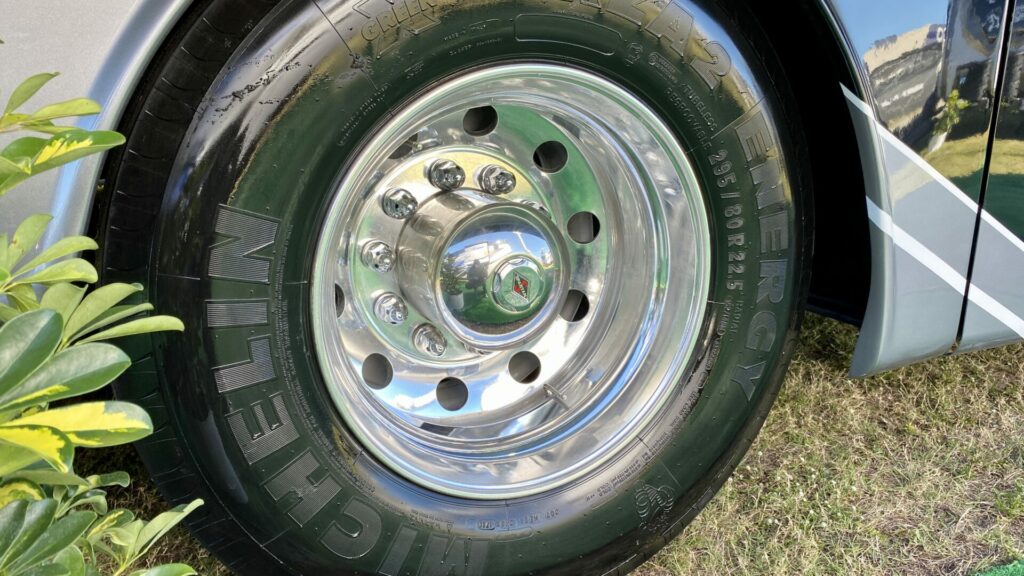
Tire Ratings
As responsible RV owners, it’s important to know your tire’s speed and weight rating, which is the maximum speed and weight you should drive to optimize the tire’s life and capabilities. Exceeding the speed rating can cause the camper tires to heat up, which weakens them and can lead to a blowout.
Tire speed ratings use an alphabetical system to indicate the tire’s capabilities. Letters towards the start of the alphabet are typically less capable and for slower speeds. Tires with ratings towards the end of the alphabet are often sportier, more capable, and designed for higher speeds and excellent traction.
Most RV and motorhome tires have speed ratings from 65 to 75 mph, which might be below a road’s posted speed limit. So make sure you know your speed rating before hitting the road.
How to Read Your RV Tires
If you look at the sidewall of your tire, it can look like a foreign language. The codes on the side of a tire provide all the information you need for your specific tire.
One of the first things you might notice is the max load information. This indication is often written very small but is easy to read because it’s not a code. It’s typically given in single and dual usage.
Here you’ll also find the max load and inflation pressure information so you know optimal tire pressure before hitting the road. Max PSI is for max cargo-carrying capacity. So it’s important to factor your RV’s weight into the picture when you’re filling up your camper tires to the proper inflation number.
Your tire’s sidewall will also have large letters that appear to be a secret code. However, it’s relatively easy to follow if you know what you’re looking for.
The first two letters are the tire type letter designation (LT, ST, etc.). You’ll then see a set of numbers that tell you the tire’s width in millimeters. Next, you’ll come to a slash and the number indicating the height-to-width ratio for the tire.
A letter indicating the radial construction and a number for the wheel’s diameter in inches is next on the list. Then there’s the load index, speed symbol, load range, and mud and snow conditions rating.
As we said, it can seem like a foreign language without deciphering the code. Consult rating charts to read the codes and select the best tire for you. When in doubt, consult a trusted professional to make sure you get the right tires for your RV and vehicle.
Safety Tip: We can’t stress enough how important it is to Understand RV Tire Speed Ratings Before You Drive. As RV owners, we need to be responsible on the road.
Setting Your RV Tire Pressure
It’s easy to be in a hurry when you’re preparing to hit the road. However, not setting your RV’s tire pressure is a step you don’t want to overlook. Hitting the road with under or overinflated tires can be extremely dangerous.
Underinflated tires will increase the friction between the tires and the road, which results in increased temperatures. This can result in a tire blowout and do severe damage to your RV.
Overinflated tires are equally dangerous. These are dangerous because they can decrease the amount of rubber touching the road. This will not only create a bumpier ride but also extend your stopping time. It creates increased wear and tear on your brakes, suspension, and tires. So check your tire pressure before every trip to save yourself a hassle down the road.
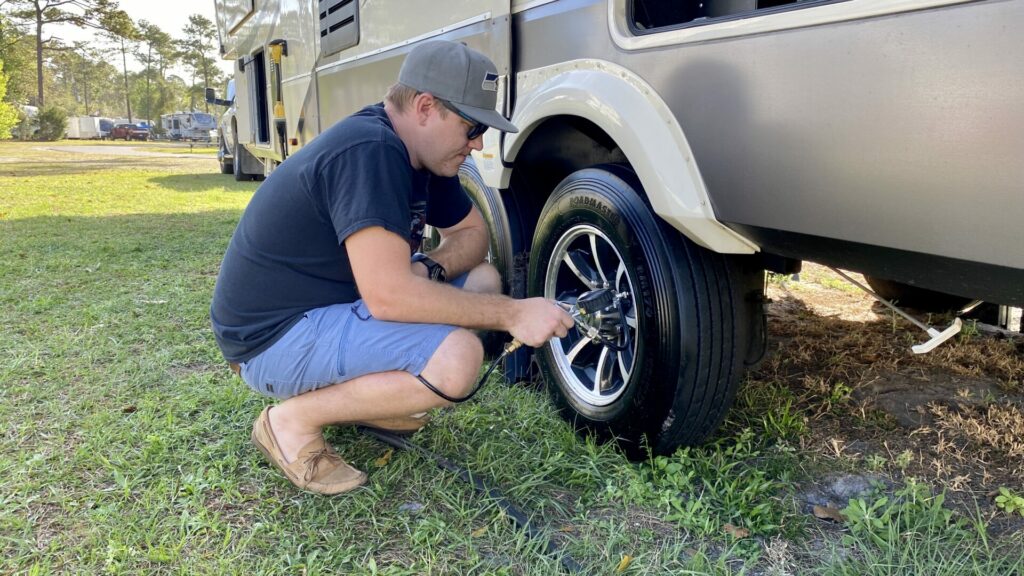
Accounting for Altitude & Temperature
Altitude and temperatures will affect your tire pressure. As you increase in elevation or the temperatures drop, the air molecules in your camper tires will compress. This can decrease the tire pressure, especially if your RV is parked and the tires cool down.
These changes aren’t significant, but it could be more of an issue if you were already low on air pressure before the altitude or temperature.
Check your tire pressure once your tires have cooled down and had a chance to adjust. Do the same when you return to a lower altitude or warmer temperatures.
Weight Matters
The more weight you’re putting on your tires, the higher your pressure will be. This is why light-weight trailers typically have tires with a PSI of 55 to 60, but larger rigs have tires with 100+ PSI.
Tires will also have a max PSI rating, which indicates the tires’ maximum pressure when cold and at a maximum weight load. Taking your RV across a scale will tell you the actual weight of your RV when it’s fully loaded so you can get the correct tire pressure.
Tire manufacturers will often have charts indicating a tire’s ideal pressure depending on the weight placed on the tire.
Have a Tire Pressure Monitoring System (TPMS)
While some will recommend a tire pressure monitoring system (TPMS), we think it’s essential. A TPMS lets you keep an eye on the temperature and pressure of your camper tires while you’re traveling.
A TPMS will alert you to any changes in temperature or pressure that could create an unsafe situation for driving. You can pull over the instant you get an alert and address the problem before it can become a bigger issue and cause extensive damage. We’ve had this happen a few times and we know our TPMS kept us staying safe on the road.
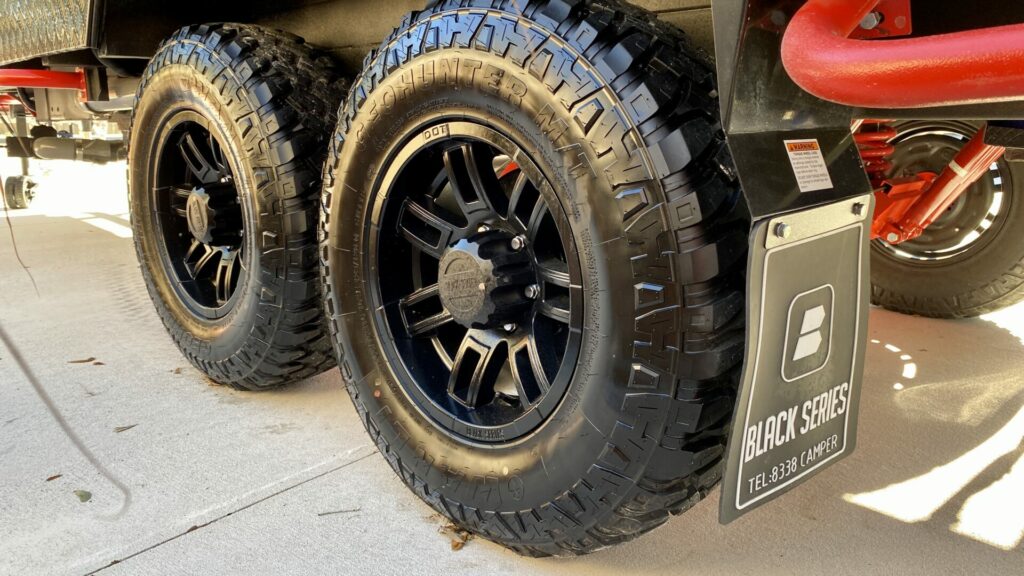
Where to Buy RV Tires
You want to get the best tires for your RV, but also the best deal. Shopping around and comparing your options is ideal. Here are a few places we suggest looking for a new set of shoes for your RV.
RV Rallies and Shows
If you’ve never attended an RV rally or show, you’re missing out. These are typically large events with numerous manufacturers throughout the industry. You’ll find discounts or special promotional offers from the various vendors on many products, including tires. The salesmen at these events can help you find the perfect set of RV tires for your rig.
Big Box Retailers
Another great option to consider for your tire purchase is your local big-box retailer. You can typically purchase new tires and have them installed on site. Since you’re buying them for a large trailer, check with the store to confirm their ability to accommodate a large trailer at their facility.
Tire Dealers
Most larger cities have a surplus of tire dealers. They specialize in tires and can get a wide range of tires quickly. These dealers can typically accommodate large RVs and travel trailers, but you should always verify first. Some dealers have locations across the country, so you can have warranty work or repairs done no matter where you take your RV.
Online
The world of online shopping has exploded in the past decade. You can buy practically anything online, including new tires. Because many online merchants don’t have a physical storefront to maintain, they can often offer discounted prices.
Remember that camper tires are heavy, so shipping costs can be a burden if the online retailer doesn’t offer free shipping.
Popular RV Tire Brands
When it comes to buying tires, we can’t recommend specific tires since each RV is so different. However, there are a few popular brands out there.
Granted, you will hear positives and negatives for each. For example, Goodyear RV tires are loved within the RV community, but you will find a whole group on Facebook that hates them.
You have to do your own research, talk to your manufacturer or dealer, and get information from a trusted resource when buying new camper tires.
Other popular brands include Firestone, Michelin, Continental, and Cooper Tires. If you’re unsure which tires to buy and have been pleased with the manufacturer-installed tires, you can always buy those again. If it ain’t broke, don’t fix it, right?
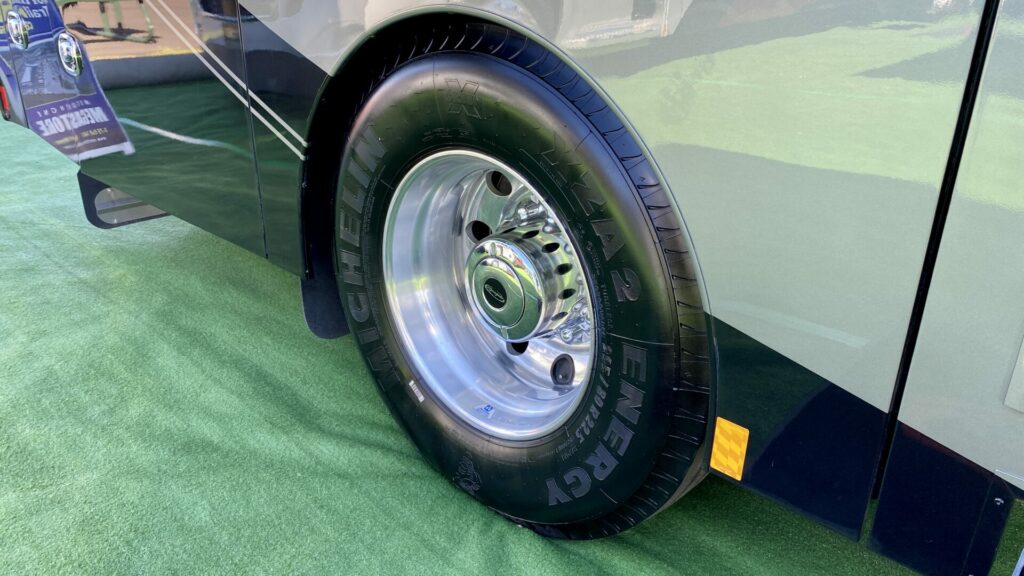
How Long Are Tires Good on an RV?
RV tires can typically last up to six years when properly maintained. However, it will vary greatly depending on how many miles you’re driving and where. Extreme temperatures can greatly reduce the life of a tire and result in more frequent replacements.
It’s always important to remember how long you’ve had your current tires and keep an eye out for an abnormal tread pattern. If you notice one part of the tire is wearing down more than the other, you might have a bigger issue related to your suspension or weight.
Do the Penny Test
Sometimes it is hard to tell if the tread wear is normal or if it’s time to buy new RV tires. One easy and relatively cheap way to test your tires is with a penny.
Place the penny sideways with the top of Lincoln’s head pointing toward the tire. You can then take the penny and place it in a groove on the tread. If you can see all of Lincoln’s head, get ready to pull out your wallet because it’s time for new tires.
How Old Is Too Old
Camper tires have a high mileage limit compared to regular car tires. Many tires can go 50,000+ miles before needing to be replaced. However, even if you stick to local camping and won’t take your RV that many miles in several decades, you’ll still need to replace your tires every so often.
Most RV tires can last up to six years, no matter how many miles you’ve driven on them. UV rays, changes in temperature, and the natural aging of rubber can cause tires to go bad as they age.
Replacement Cost
Replacing an entire set of tires is typically cheaper than repairing the damage that can occur to your RV if you were to have a blowout. Always carry a spare and have some money set aside for routine maintenance items like replacing your tires. You don’t want a surprise expense like this to derail your RVing adventures.
Be in the Know About RV Tires
Your RV’s tires are what keep you rolling down the highway. You wouldn’t go anywhere without them. You must do your due diligence to protect them and keep them in optimal shape. If you take care of them, they’re more likely to take care of you.
What type of tire do you have on your RV?




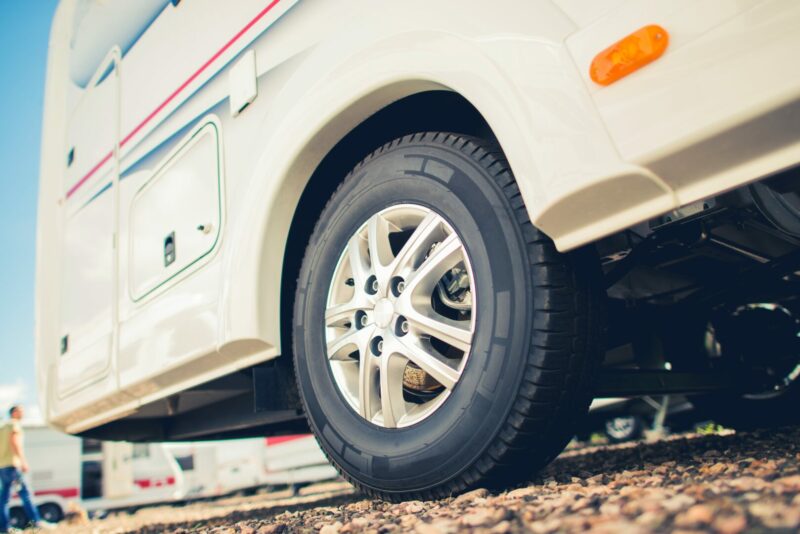


Measured tire pressure is not absolute, but rather the difference between inside & outside. Gases expand when temperature rises, so measured pressure diminishes with cold and increases with heat.
Increasing altitude decreases outside pressure, so the relative pressure in the tire increases.